Card game
Kids Scrabble: Rules and Guide
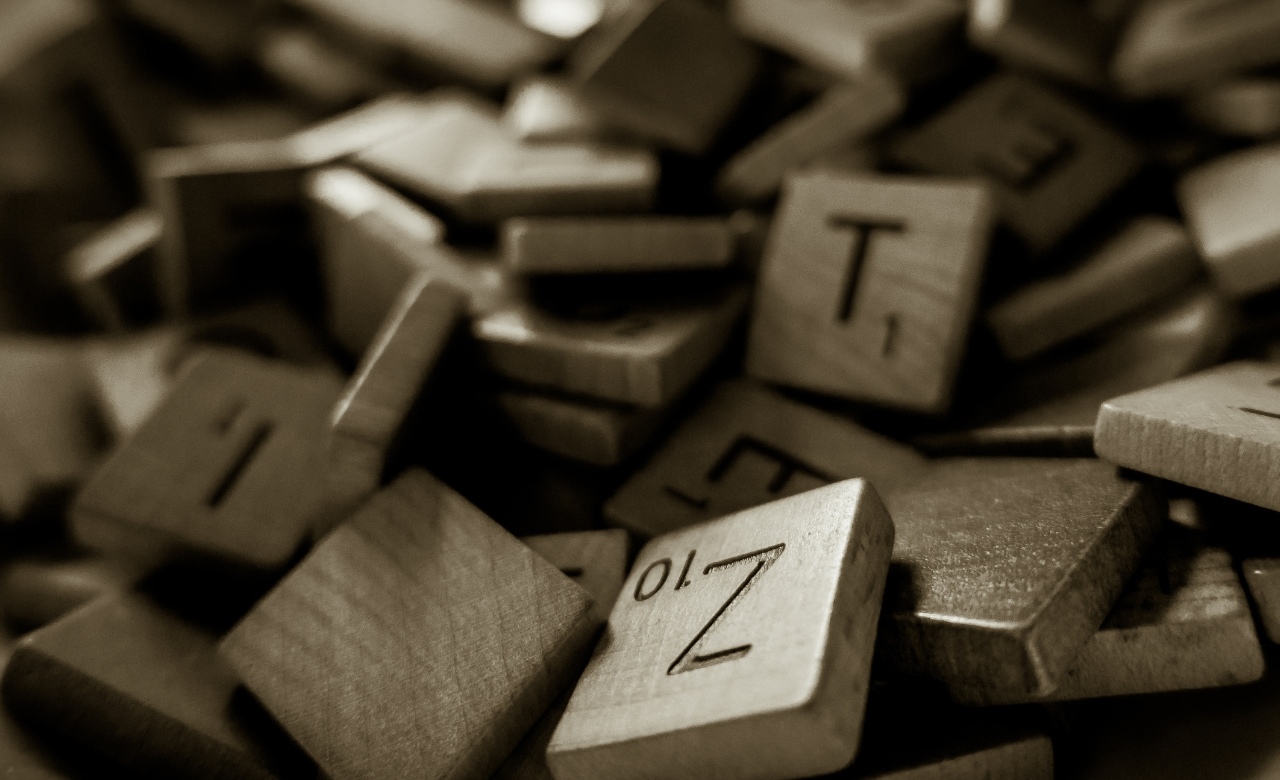
In this article, we will dive deep into the amazing world of Kids Scrabble. An exciting and educational letter game that children of all ages and adults at heart can enjoy. We will look at its richness through its rules, history and the amount of fun it generates.
What is Child Scrabble?
Kids Scrabble is a simplified version of the classic Scrabble game. Instead of cryptic crossword puzzles, Kids Alpha has simpler words and terms that are suitable for children, making it the perfect game to introduce your little ones to letters and words in a fun and interactive environment.
History
Originally created by Alfred M. Butts in 1938, Scrabble took the world by storm. However, to make the game more accessible to children, Kids Scrabble was added. The idea was to give children the opportunity to practice their reading skills and improve their vocabulary while having fun.
Objective of the game
The goal of Kids Scrabble is to create words by crossing letter tiles on the game board. Each correct word scores points based on the value of the letters. When all the tiles are finished, the player with the highest score wins.
| Game title | Country of origin | Minimum age |
|---|---|---|
| Children Scrabble | USA | 5 years |
| Languages | Number of players | Playing time |
| Swedish | 2-4 | 30-60min |
| genre | Year of publication | Publishers |
| Word games | 2005 | algae |
Rules for Kids Scrabble

The game Barn Alfapet is not only a great playground for children’s creativity and vocabulary, but also an excellent platform for learning to follow rules. Its basic rules are quite simple, but some details may require more attention.
With word lengths limited to a maximum of five letters, the game creates a great opportunity for children and adults to find common ground. By following the notes on the game board and using a good strategy, Scrabble becomes an exciting challenge for both parties.
Game materials
Scrabble’s game package contains various components that contribute to its unique character. Below you will find the most important parts:
- Game plan: A colorful board where players put down their words
- Letter tiles: A mixture of tiles with letters and numbers. Quantity and point value vary depending on the use of the letter in the Swedish language.
- Stand: A place where each player can put down their letter tiles without other players seeing them.
Preparation
The game starts with all the letter tiles face down. Each player draws seven tiles and places them on their stand. It is important to note that the number of tiles on the stand should always be seven after each player’s turn, until the end of the game when all tiles are taken.
Rules of the game
To start the game, the players choose who will start. Most often this can be done by seeing who can form the longest word with their first seven tiles. The game then continues clockwise. An average round can vary in length, depending on the number of players and their alpha-pet strategy. The important thing is to keep the flow of words alive and the energy high for a great gaming experience!
Phases of the game

To have a successful game of Kids Scrabble, we will go through the different phases. This helps structure the game and makes it easier to navigate for beginners.
Drawing tiles
The first step is for all players to draw seven tiles each from the bag. Whoever draws the highest letter starts the game. It is important not to show the tiles you have to the other players!
Place tiles on the playing field
The game starts with the first player placing their first letter tiles on the board. They must lay out at least two tiles. This can be a challenge but take it easy, over time you will develop a sense of which words score the most points.
Replacing tiles
This phase is optional and is activated if a player is unable or unwilling to place any tiles. The player can then choose to change any or all of their tiles. But remember, this costs a round!
Now that you know the phases of the game, you can start using strategies to earn more points. Here we list three basic tips:
- Kids Scrabble rules: Understand the rules! Being fully aware of the rules allows you to use them to your advantage.
- Kids Scrabble tip: Think ahead! Always planning your next move will give you an advantage in the game.
- Kids Scrabble strategy: Use all your tiles! Each tile on your holder at the end of the game round means minus points, so try to get rid of all of them.
Complete the game
Once you have used all your tiles, and there are no more free tiles to draw, it is time to complete the game round. Whoever closes the game will be rewarded with a bonus equal to the total point value of the opponent’s remaining tiles. The player with the highest final score after everything has been counted is the winner.
Summary
Kids Scrabble is a great game for practicing word skills and strategic thinking. With its simple rules but deep strategic meaning, the game can entertain both young and old for hours. Here are some important points to remember:
- Tiles: Always keep track of how many tiles you have left – when they run out, you complete the game round.
- Word choice: Think about choosing words that give you the most points, but beware of being blocked by your opponents.
- Bonus points:: Don’t forget that the player who finishes the game is awarded bonus points equal to the total point value of the remaining tiles of the other players.
Frequently asked questions – FAQ
What if I can’t form a word with my tiles?
No problem, you can replace as many tiles as you like during your turn, but you lose your turn to form a word.
How do the points in the game count?
Simple. Each letter tile has a point value printed on it. When forming a word, add up the point value of each letter in the word. If you can put your word on a bonus square, the word’s score is multiplied by the value indicated on the square.
What is the best way to win in Kids Scrabble?
The key to winning Child Scrabble is finding the balance between creating high value words and blocking your opponents’ attempts to do the same. Remember to use bonus fields smartly to maximize your points.
Card game
Skipbo – Game rules and guide

Welcome to a world of strategy and fun – Skipbo – a card game that brings generations together in a diverse mix of tactics and luck. Skipbo is a card game inspired by the classic game ‘Spite and Malice’. The game first became popular in the 1960s in the US and has since become a popular favorite all over the world.
What is Skipbo?
Skipbo is a strategy game that can be played by 2 to 6 players. The game consists of a shuffled deck with cards labeled from 1 to 12 and 16 “skipbo” cards that act as jokers. Learning the basics of the game is easy, but the challenge is in managing your deck and strategizing to be the first to get rid of all your cards.
Components of the game
The Skipbo game consists of 162 cards. 144 of these cards are numbered from 1 to 12 and the remaining 18 cards are the Skipbo cards which can be used as any number in the game. Each player also has their own ‘Player Pile’ of cards, and there are extra short piles called ‘Uncovered Piles’, ‘Draw Pile’ and ‘Build Pile’ on the table.
Objective of the game
The goal of the game is to get rid of all the cards in your ‘Player pile’. To do this, players build sequences of cards in numerical order in the center of the game board. The Skipbo cards act as wild cards and can be used to replace other cards in your sequences.
| Description | Components | Objectives |
|---|---|---|
| Skipbo is a popular card game | 162 cards marked from 1-12 and 18 skipbo cards | Be the first player to get rid of all the cards in your player pile |
| The game combines strategy and luck | Pile of players, Uncovered piles, Pile of rubble and Construction piles | Build sequences of cards in numerical order |
| Can be played by 2 to 6 players | Skipbo card can be used as any number | Skipbo cards are essential for developing your strategy |
| Collect rounds for profit | Each round is played until one player runs out of cards. | Play smart, fast and with a smile on your face |
Preparations

Before the world of Skipbo can begin, appropriate preparations must be made. These include setting up the game in an orderly fashion and clarifying the rules. In this way, all players will have a clear and fair gaming experience. But don’t worry, it may sound complicated, but it’s actually quite simple once you understand the basics!
Layout of the game
Skipbo’s layout is crucial. Make sure that all players have enough space for their place of play. Each game should have a draw pile, build pile and a hand of cards. The central playing area should be large enough for all players’ common piles.
The ranking of the cards
Your card rankings play a crucial role in the game’s progression. Here is a handy list of the cards’ ranking in Skipbo:
- Card 1: Lowest rank
- Cards 2-12: Numbered from lowest to highest
- Skipbo card: Can be used as any number, the highest ranked card
Rules of the game
A round of Skipbo starts with the person sitting to the left of the dealer. The game then continues clockwise. It is always important to keep an eye on who would be the next to draw hands on the cards, and that is the key to winning. Know your skipbo rules!
How to play Skipbo:

Come on, let’s dive straight into the fun! Playing Skipbo is certainly not a lengthy process, but it requires accuracy and strategy to master. It is in many ways like a skilled puzzle!
The course of the round
A round of Skipbo requires each player to take their turn and play cards from their hand, their building piles and the central pile. Each player’s goal is to eventually get rid of all their cards. It’s actually harder than you think, but also more exciting than you can imagine! Let’s dive deeper into how it works.
- Start with cards in hand: Each player starts the round with a hand full of cards.
- Playing cards: The player must then try to play these cards correctly.
- End of round: A player continues to play cards until they cannot or choose not to play any more cards.
Playing cards from the hand
It may sound simple to play cards from the hand, but this is where the brilliance of Skipbo really shines. The choices you make here can literally determine whether you will win or lose the game. Every decision counts, so it’s best to be on your toes!
Construction piles and central piles
In Skipbo, players work on both their own building piles and the shared central piles. These decks act as the heart of the game – this is where much of the action takes place!
- The building piles: Each player has up to four personal building piles they can build during the game.
- The central piles: There are also four central piles that all players can build on, but only in increasing order, from 1 to 12.
- Winner: The first player to get rid of all their cards in the draw pile wins.
I hope you now have a better idea of skipbo rules and that this serves as a good skipbo guide. I will continue to dig deeper into skipbo tips and skipbo strategy in future articles. Always remember, the strategy you choose can really change the course of the game, so always think two steps ahead!
How players interact
A characteristic of Skipbo is the cooperation of the players. The game is based on all players working together to create orderly card sequences. From the smallest denomination up to the highest, it is always a joint effort. But don’t let the joint effort fool you, there is a lot of strategy involved. Using your cards smartly to prevent your opponent from making their move can be the difference between winning or losing.
Summary
Skipbo is a game of teamwork and strategy. Each player must think two steps ahead, to stay ahead of their opponents. While cooperation is central to the game, it is important to remember that it is also a competition. Use your skipbo rules, skipbo tips, and skipbo strategy to gain the upper hand. And don’t forget to enjoy the game, because in the end it’s all about having fun!
Frequently asked questions – FAQ
Can you only draw one card at a time?
No, each player has the right to draw up to five cards from their own pile at the start of their turn, as long as they do not exceed the hand limit.
Why is it important to keep the cards in order?
The order of the cards is important as it helps players to create sequences. Without these sequences, it would be impossible to win the game.
How do you decide who starts the game?
Who starts the game is usually determined by drawing cards from the deck. The player with the highest card takes the first round of play. An alternative method could be that the youngest player starts.
Card game
Texas Holdem Poker: Rules and Guide

Welcome to the classic game of Texas Holdem Poker – an entertaining mix of strategy and luck! Are you new to poker or just want to brush up on your skills? You have come to the right place! We’ll cover everything you need to know to get started – the basic rules, the components of the game, hand rankings and much more.
Introduction to Texas Holdem Poker
Texas Holdem Poker, often called “The Cadillac of Poker”, is one of the most popular poker games around the world. Its popularity is due to its unique blend of strategy, skill and luck. The game is quite simple to understand, but can take a lifetime to master. Ready to dive in?
Basic rules for Texas Holdem Poker
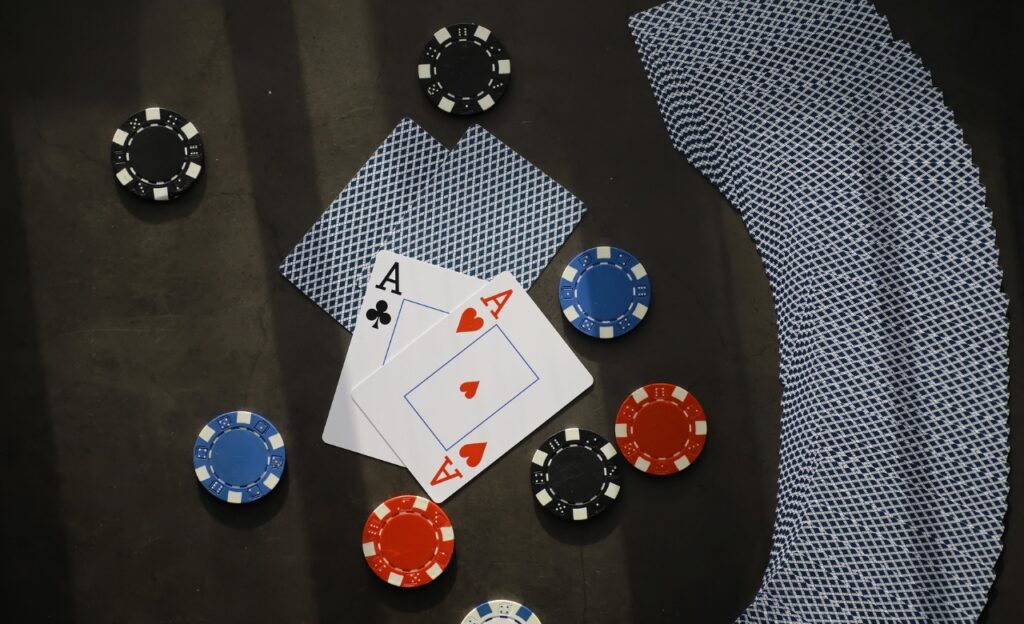
To play Texas Holdem, you need to understand some basic rules. Each player gets two private cards, also called ‘hole cards’, which belong to them and them only. Then five community cards are laid out on the “table”. Your goal? To make the best possible five-card hand from your two private cards and the five community cards.
Game components
To play Texas Holdem you need a poker table, chips, a 52-card deck and 2-10 players. Each player starts with the same amount of chips, and the aim of the game is to win all the opponents’ chips.
Sharing of cards
The game starts with two ‘blind’ bets being placed in the pot by the two players to the left of the ‘dealer’. Then two private cards are dealt to each player, starting with the player to the left of the big blind.
| Term | Description | Example |
|---|---|---|
| Blinds | Blind bets placed before the cards are dealt | Little blind, big blind |
| Private Cards | The two cards that only the player can see | King and Queen in hearts |
| Common Cards | The five cards on the table that all players can use to make the best possible hand. | 5, 6, 7, 8, 9 in clubs |
| Round of intervention | A period of the game where players can bet on their hand | Flopp, Turn, River |
Efforts
Betting in Texas Holdem poker can feel convoluted to the novice, but don’t worry, it’s not as complicated as it seems! There are two main types of actions: the mandatory actions, in the form of blanks, and voluntary actions, which are placed during the betting rounds. Each game starts with two players placing the mandatory bets. This is where the game really begins!
- Great Darkness: This bet is mandatory and is placed by the player to the left of the dealer.
- Little Dark: This bet, usually half the size of the Big Dark, is placed by the player to the left of the player who placed the Big Dark.
- Voluntary Bets: These bets are placed during the betting rounds, and can vary in size.
Betting rounds
The betting rounds in Texas Holdem poker are where most of the action takes place. There are four betting rounds in total, and each round gives players the chance to bet, check, call, raise or fold. These choices are crucial, as they affect both the size of the pot and which players remain in the game.
Display of cards and winning hand
After the final round of betting, the moment everyone has been waiting for – showing the cards! And this is where the winning hand is decided. In Texas Holdem poker, the best five-card hand wins. These five cards can be a combination of the player’s two face-down cards and the five community cards. In addition, if two or more players have the same winning hand, the pot is split equally between them.
Texas Holdem Poker Ranking of Hands
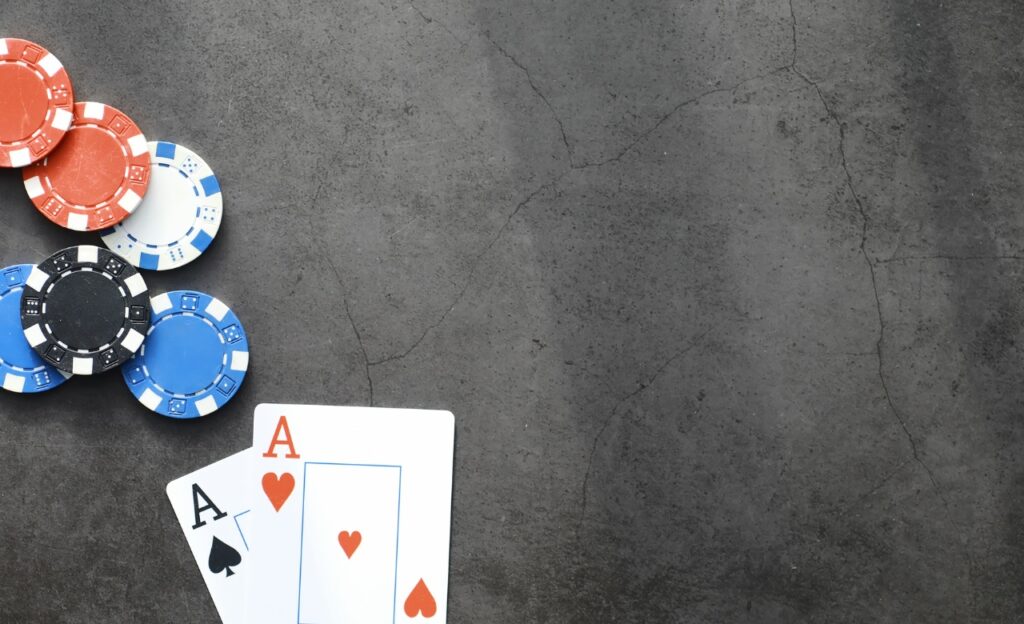
Understanding hand rankings in Texas Holdem poker is one of the pillars of becoming a successful player. Whether you play for fun or compete at a high level, knowing the hand rankings is extremely important!
Highest hand
In Texas Holdem poker, the highest hand you can have is a royal flush. It is a hand consisting of a ten, jack, queen, king and ace of the same suit. However, it is very rare to see such a hand in practice. Still, the feeling of landing one is indescribable!
Par
The essence of Texas Holdem Poker lies in understanding the hand rankings. To achieve a pair, it is enough to have two cards of the same rank in your hand. It is actually the most common type of hand that players receive in the game. To give you a clearer picture, let’s explore some examples:
- Case 1: You have two cards of the same rank (e.g. two aces) as your hole cards.
- Case 2: You have one card in your hand and the corresponding pair is among the community cards.
Pair of twins
When playing Texas Holdem Poker, two pairs actually trump one pair. This occurs when your best poker hand consists of two different pairs, along with a fifth unranked card. Getting two pairs requires a bit more skill and strategy. The more games you play, the better you become at identifying when you can get two pair and how to use this hand to your advantage.
Triss
Getting a three of a kind in Texas Holdem Poker means you have three cards of the same value, regardless of suit. This hand can come in handy, especially when playing against multiple opponents. There are several ways to achieve a triss, and the more you play, the more intuitive these patterns will become for you.
Bridges
Another popular hand to aim for is ‘The Ladder’. This means that you have five cards in numerical order, regardless of color. The uniqueness of creating a ladder is that the ability to think ahead comes in handy here. Being able to predict which cards will be drawn next can give you a huge advantage and increase the chances of creating the most impressive ladder!
Color
One of the strongest hands in Texas Holdem poker is called Suit, and it occurs when all five cards in your hand are of the same suit, either hearts, spades, clubs or diamonds. The detail here is that the order of the cards does not matter; all that is needed to get a Color is that they are all the same color. A tip to remember is that if two players both have a color, the player with the highest ranked card wins the hand.
Barracks
Speaking of strong poker hands, Kåk is also high on the list of strong hands in Texas Holdem poker. A Kåk consists of a pair and a trick, which means you have two cards of the same rank and another three cards of another same rank. If two players both have a Kåk, the trick is looked at first; the player with the higher ranked trick wins the hand. If the threes are equal, it is decided by seeing which pair is the highest.
Summary
Texas Holdem poker may seem complicated to the uninitiated, but the fact is that once you learn the basics and all the different hands, it quickly becomes a game that is as fun as it is strategic. Those basics include understanding the order of the hands, knowing when to bet, and having a basic strategy to optimize your chances of winning.
Frequently asked questions – FAQ
What is “Color” in Texas Holdem Poker?
Suit is when all five cards in your hand are of the same suit, either hearts, spades, clubs or diamonds.
What does it mean to have a ‘shack’?
A Kåk in Texas Holdem poker means that you have a pair and a three of a kind, i.e.. two cards of the same value and another three cards of another same value.
How can I get better at Texas Holdem Poker?
Becoming proficient in Texas Holdem poker requires patience and practice. A good way to start is to understand all the rules and the different poker hands. After that, you can start analyzing and understanding different strategies to improve your chances of winning.
Card game
Uno Games: Rules and Guide

Welcome to our in-depth guide to the popular card game Uno. Here we dive straight into the game’s basic rules, offer strategy tips, and provide an at-a-glance guide for anyone who wants to learn more about this classic card game.
What is Uno Games?
Uno is one of the world’s most beloved family games. In this card game, designed in 1971, players aim to get rid of all their cards to squeeze out a winning “Uno!”. and then win the game. The game involves strategy, luck, and the ability to read your opponents’ behavior.
Uno Games: card overview
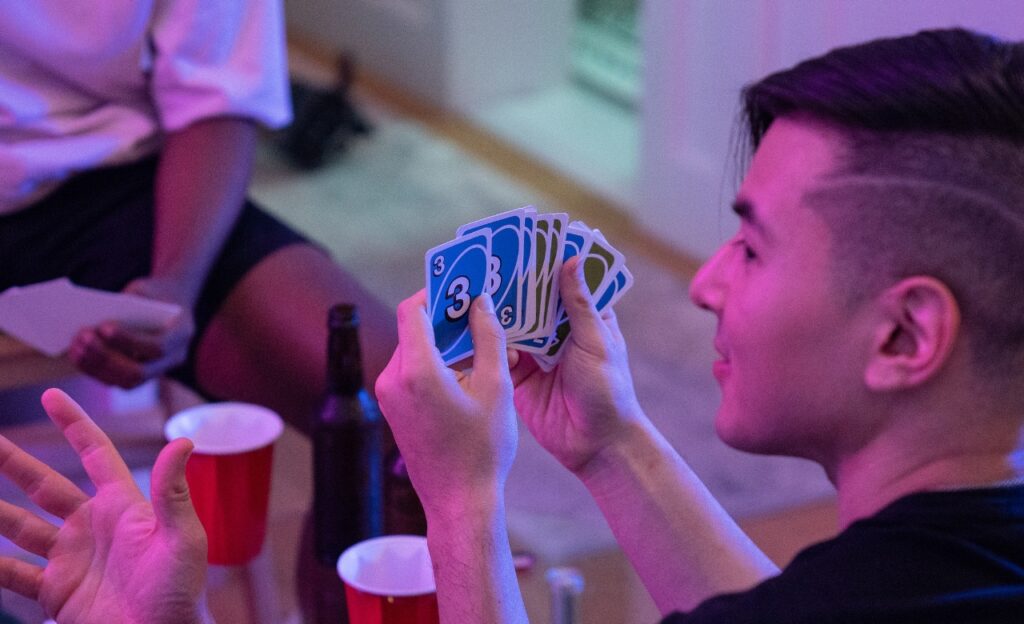
In the Uno game, a special card deck is used that consists of 108 cards, divided into four different colors (red, yellow, blue, green), with numbered and special cards in each of these colors. Each card has a unique power that can change the outcome of the game in the blink of an eye.
Game materials
The Uno deck contains 108 cards. There are four colors and each color contains numbered cards from 0-9, as well as special cards like ‘Skip’, ‘Reverse’, ‘Draw Two’, ‘Wild’ and ‘Wild Draw Four’. This approach offered a profound strategic dimension to the game.
Reshuffling and distribution of cards
Before the game begins, the Uno cards are shuffled well and each player receives seven cards. The rest of the cards are placed face down in a discard pile in the center of the playing area, and the top card is turned over to form the discard pile.
| Card | Color | Effect |
|---|---|---|
| 0-9 | Red, Yellow, Green, Blue | No particular effect |
| Skip | Red, Yellow, Green, Blue | Next player misses his turn |
| Reverse | Red, Yellow, Green, Blue | Change the order of play |
| Draw Two | Red, Yellow, Green, Blue | The next player must draw two cards |
| Game | – | Choose any color |
| Wild Draw Four | – | Choose a color and the next player must draw four cards |
Uno Games: Goals
The primary goal of the Uno game is to be the first player to get rid of all their cards. But it is not as easy as it sounds! You need to use tactics, strategy and a bit of luck to succeed. Consider the following key points:
- Remove cards: You should remove a card from your hand at each turn, if possible.
- Matching cards: You must match the top card of the junk pile, either by color, number or symbol.
- Say ‘Uno’: You should say ‘Uno’ when you have only one card left in your hand.
Rules of the game
The game starts with the dealer dealing seven cards to each player. Then the dealer turns over the top card of the deck and places it on the table to start the junk pile. The game proceeds clockwise from the dealer, but the direction may change during the game.
Card management and succession of games
In each turn, the player should match the top card of the junk pile, either by color, number or symbol. If the player cannot lay a card, he or she must draw a card from the draw pile. If the drawn card can be placed, the player may do so immediately. The game continues until a player has placed their last card.
Playing cards based on rules and supplements
The winner of each round scores points based on the cards the other players have left in their hands. Winning is determined by first reaching a predetermined point limit, usually 500. But if you want to spice up the game a bit, there are several fun additional rules you can introduce! These include:
- Stacking: Allows players to stack multiple Draw 2 or Wild Draw 4 cards on top of each other.
- Jump-in: If a player has exactly the same card (same color and number) as the card just laid, they can play that card out of turn.
- Seven-O: When a 7 or a 0 is played, there is a rotation of cards in the hand.
Uno Games: Preparations
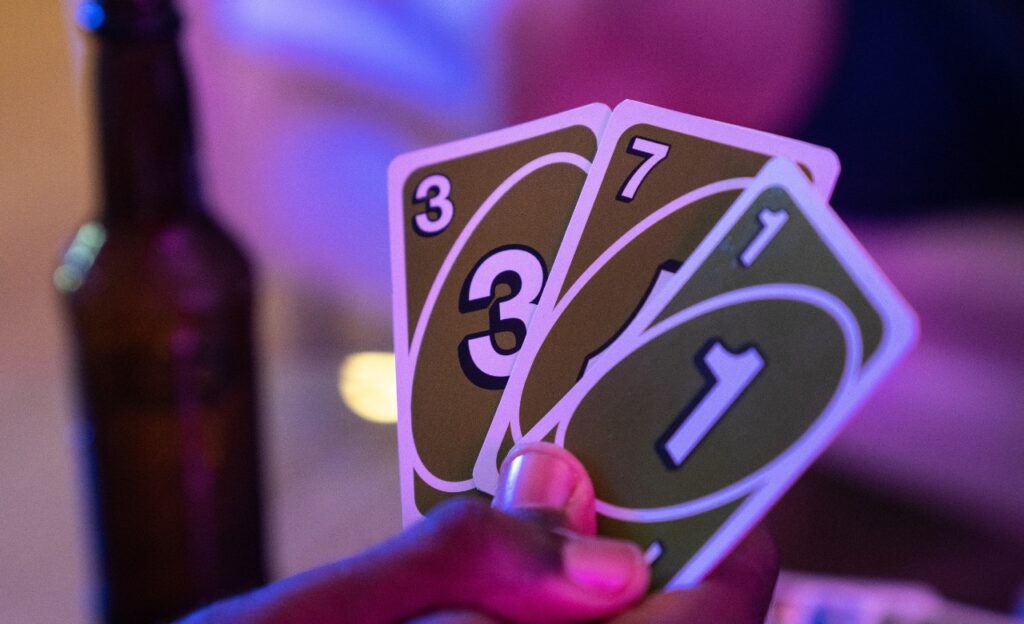
Before you start your exciting game of Uno, you need to make some preparations. Start by shuffling, dealing the cards and choosing the starting cards. Uno is not only a game of luck, it is also about strategy and smart thinking. Be sure to prepare everything properly to be able to focus fully on the game.
Start card
The first step in the Uno game process is to distribute the starting cards. Each player should receive seven cards each. The cards should be shuffled so that no one knows what he or she will get. This introduces an element of surprise and excitement into the game.
- Number of players: 2 to 10 players can participate in Uno.
- Card distribution: Each player receives 7 cards at the start.
- Coverage of cards: No other player should be able to see your cards.
Setting up and using special cards
The Uno game contains various special cards that can affect the turn of the game or the actions of other players. These cards can be used strategically to win the game. Almost all players see these cards as their secret weapons! Special cards can block other players, force them to draw cards or change the order of play.
Changing colors and numbers
A big part of the strategy behind Uno is the ability to change the color and number of the game. With the right timing, these powerful moves can transform the direction of the game and help you win! Whether you switch to a color that favors you or change the numbers to set up your opponents, a well-planned switch can make a big difference. It is important to remember that the basic game of Uno is driven by turns, planning and a bit of luck!
Uno Games: Exit the game
When playing Uno, it is important that you know when and how to end the game. After a player has placed their last card, i.e. when a player runs out of cards, the game is over. If the game ends before any player has any cards left, the player with the lowest score wins.
Uno Games: Scoring
The points in the Uno game are easily counted. Each number card is worth its number, for example, a card numbered 5 is worth 5 points. Action cards like Draw Two, Skip and Reverse are worth 20 points each? While Wild and Wild Draw Four cards are worth the most with 50 points each.
Uno Games: Tips and Strategy

The best tips and strategies for winning the Uno game include keeping track of your opponents’ cards and always using your special cards at the right time. Here are some key points to consider:
- Keep track of your opponent‘s cards: Always keep an eye on what color and numbers your opponents are playing with the most.
- Using your special cards smartly: Using your special cards at the right time can really turn the game in your favor.
- Hold back your Wild cards: It’s often best to hold back your Wild cards for as long as possible so that you can use them in crucial situations later in the game.
Summary
Uno is a very fun and engaging game that can be enjoyed by people of all ages. It is played with a special set of cards and involves a lot of strategy and planning. We hope that this guide has given you a deeper understanding of the Uno Game: its rules, scoring and strategies.
Frequently asked questions – FAQ
What does it mean to shout ‘Uno’?
When a player has only one card left to play in their hand, that player must call “Uno”. If the player forgets to call Uno and another player points this out before the next player’s turn starts, that player must draw two additional cards from the deck.
How many points is each Uno card worth?
Number cards are worth their printed value, action cards are worth 20 points and Wild cards are worth 50 points.
What happens if a player cannot play a card?
If a player does not have a valid card to play, the player must draw a card from the draw pile. If the drawn card can be played, the player may do so.
-

 Card game1 year ago
Card game1 year agoSkipbo – Game rules and guide
-

 Rules of the game1 year ago
Rules of the game1 year agoYatzy: Rules and Guide
-

 Card game1 year ago
Card game1 year agoRummy: Rules and Guide
-

 Rules of the game1 year ago
Rules of the game1 year agoYatzy Bonus: Rules and Guide
-
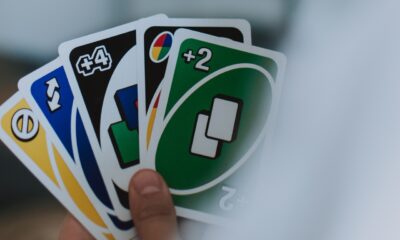
 Card game1 year ago
Card game1 year agoUno Games: Rules and Guide
-

 Rules of the game1 year ago
Rules of the game1 year agoMonopoly: Rules and Guide
-

 Rules of the game1 year ago
Rules of the game1 year agoKalaha Swedish: Rules and Guide
-

 Rules of the game1 year ago
Rules of the game1 year agoSweden The Game Board Game: Rules and Guide














